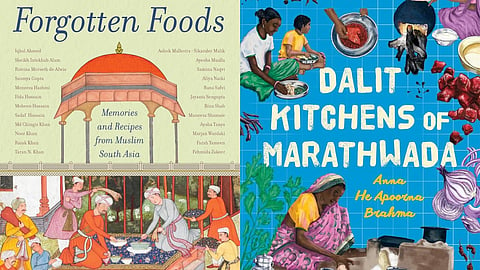
- HOMEGROWN WORLD
- #HGCREATORS
- #HGEXPLORE
- #HGVOICES
- #HGSHOP
- CAREERS
- ABOUT US
- CONTACT US

Food has always been more than sustenance in the Indian subcontinent — it is a marker of caste, class, familial and tribal affiliations, kinship, and identity across a complex intersectional web of personal and communal politics, lineage, heritage, religiosity, and ethnicity. In India, as in the rest of South Asia — more so than anywhere else in the world — what we eat, how we eat, and who we eat with represent who we are.
In recent years, a growing number of homegrown food writers have confronted the complicated politics of food as a metaphor for memory, history, and identity through ethnography, oral history, memoir, and activism. This emerging canon has moved beyond the confines of conventional food writing to explore how certain recipes carry the weight of lived experiences, generational traditions, and collective memory.
In Archana Pidathala's 'Five Morsels of Love', the author draws from her grandmother G Nirmala Reddy’s 1974 Telegu cookbook 'Vanita Vanṭakālu' to capture a cross-section of their family recipes along with anecdotal stories and narrative introducing readers to the flavours of Andhra Pradesh.
This is not simply a translation or a recreation — it is an intimate portrait of a woman, a family, and a region, meticulously crafted through recipes and personal history. Here, food writing becomes a form of archival work — one that honours matrilineal knowledge passed through generations of mothers and daughters, and celebrates the emotional labour of making food that often goes unrecorded and unacknowledged.
Similarly, 'Memories on a Plate: Stories from 100 Indian Kitchens' captures the inseparable connection between food, memory, and culture through personal anecdotes, recipes, art, poetry, and photo essays from 100 Indian kitchens across the world. The anthology, curated by Nivaala and The Alipore Post, interlaces essays and recipes with reflections on loss, migration, community, and celebration. In 'Memories on a Plate', food becomes a site of memory — a means of preserving not only family traditions, but also the textures of time, place, and the intangible, impermeable knot of emotions. Here, the act of preparing or eating a particular dish becomes a way of summoning childhood memories, revisiting left-behind homelands, or resurrecting a departed loved one's presence.
Meanwhile, Shahu Patole's 'Dalit Kitchens of Marathwada' and Farokh Talati's 'Parsi: From Persia to Bombay' push the envelope further, documenting the culinary histories of marginalised and diasporic communities and underscoring how food is central to identity and self-assertion. These texts serve a dual archival and political purpose — preserving what risks being lost and affirming what deserves to be seen.
In Dalit Kitchens of Marathwada, Patole makes a vital intervention, documenting the food practices of Dalit communities that are often left out of mainstream culinary discourse. Through recipes, testimonies, and memoir, Patole highlights how food can be both a marker of caste exclusion and an instrument of Dalit resistance and pride. The book reminds us that kitchens are political spaces, and cooking is often an act of assertion and self-definition.
On the other hand, Parsi: From Persia to Bombay draws from Talati's decades of experience as a professional chef and his inheritance of heirloom recipes passed down from the home kitchens and dining tables of his ancestors. In Parsi, Talati creates a comprehensive guide to Parsi cuisine as well as an intimate account of the cultural and personal histories preserved within this unique culinary tradition.
Similarly, 'Desi Delicacies: Food Writing from Muslim South Asia', 'Forgotten Foods: Memories and Recipes from Muslim South Asia', and 'Degh To Dastarkhwan: Qissas and Recipes from Rampur Cuisine' trace how closely culinary traditions were intertwined with courtly rituals and spiritual practice in Muslim South Asia. Part food memoir and part oral history, these books shed light on how South Asian Muslim communities prepare and consume food, but also why it matters and what it means to the culture, the household, and the community at large.
Together, these bodies of work map the diverse, intersectional history of the subcontinent through the region's many food cultures and culinary traditions and remind us that food writing in India is no longer just about technique or taste — it is about memory-making, resistance, kinship, and the power and politics of making and consuming certain foods.
If you enjoyed reading this, here's more from Homegrown:
Dalit Identity And Food – Memories Of Trauma On A Plate
Shahu Patole’s New Book Serves Up A Powerful Critique Of Caste Through The Lens Of Food
'Memories on a Plate' Is A Culinary Anthology Exploring Memory, Nostalgia and Home
